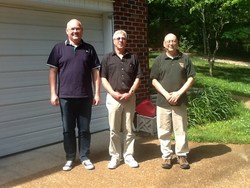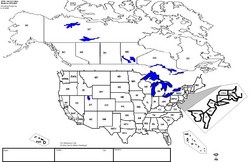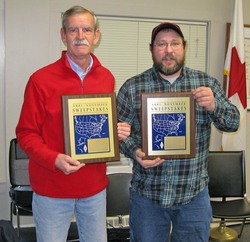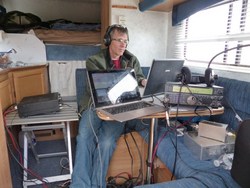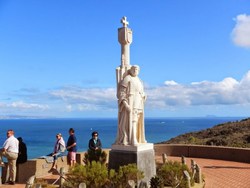 June 4, 2014 Editor: Ward Silver, NØAX | |||||||
IN THIS ISSUE
NEW HF OPERATORS - THINGS TO DO Why not try one of the many short Morse code "sprint" contests such as the NS Sprint (which is fast) or the NAQCC Monthly QRP Sprint (slower.) Most of these contests are weekly or monthly so there's always another just around the corner. These give you an opportunity to get some CW practice without the hurly-burly of a major weekend contest. BULLETINS There are no bulletins in this issue. BUSTED QSOS Your editor managed to avoid potholes on the information highway last time. CONTEST SUMMARY Complete information for all contests follows the Conversation section June 7-8
June 14-15
With WRTC-2014 coming up quickly - just five weeks! - you should be thinking about your strategy, too. There are a number of participation awards for those of us not sharing a tent with a team mate in New England. Since the earliest WRTCs, there have been novel prizes and awards, such as the deck of WRTC cards for the WRTC-1996 held in San Francisco. WRTC-2014 has its own contest within a contest - the WRTC2014 Chase. Gold, silver, and bronze awards recognize operators who work the WRTC stations on as many bands and modes as possible. The "Assistant Judge" award encourages you to email your IARU HF Championship log to the WRTC sponsors within six hours after the contest is over. Whether you operate a little or a lot, jump in and join the fun!
A highly anticipated presentation at the Dayton Hamvention's Contest Forum was "Introducing N1MM Logger Plus." The quarter-million lines of code (so I'm told) have been transported to a new framework that upgrades the way many important functions are displayed. The development team has obviously listened closely to the contest community, making better use of color and data display techniques. If you would like to learn more about the changes, the presentation is archived as MP4-format files on the N1MM Logger website. (Thanks, Larry K8UT) The Roadrunners Microwave Group (RMG) invites all hams to the 48th Annual Central States VHF Conference in Austin, Texas, from July 24-27th. This year's conference theme is QRO, or creating high power on the VHF+ bands. There is an impressive list of speakers supporting this topic and many others including oscillator design, antenna construction and station design and construction. The conference also features noise figure and gain measurement, dun noise measurement, prizes, and a rover and dish bowl (Thanks, Steve N5AC) Reverse Beacon Network (RBN) leader, Pete N4ZR, announces, "We're trying hard to move to a wholesale/retail model, encouraging end-users of RBN data to connect to one or more of the many cluster nodes that are set up to serve you with filtering and other capabilities. Extensive TELNET listings are available online - - look for entries that have "(+CW Skimmer)" in the first column."
The new, free ARRL practice exam service is now "live." Covering all three classes of the U.S. amateur exams - Technician, General, and Extra -- ARRL Exam Review was designed for ARRL by DHF Systems, the creator of ARRL's TravelPlus for Repeaters⢠software. How did they do it? Capture a spacecraft, that is. An IEEE article describes how volunteers, including many radio amateurs were planning to command a 35-year-old NASA spacecraft, the International Sun-Earth Explorer 3 (ISEE-3). As announced a few days ago, they were successful and are now planning a comprehensive assessment of the spacecraft's general health. If all goes well, they will attempt to fire the satellite's engines to place it one of several gravitationally stable locations known as the Langrangian points. You can keep current on the program's status at Space College. Web Site of the Week - Jim W4ENE has announced the release of an updated version of PIZZA, which is a polar-projection mapping program that offers a variety of configurations and options. WORD TO THE WISE BIC - not the pen, it's an abbreviation for "butt in chair" which is how you exceed your contest goals and win some of those certificates and plaques. You can't click without BIC! You weren't imagining things if you thought you heard ARRL Public Relations and Media Manager, Sean KX9X on NPR last week. A story on the ARRL's centennial featured several segments with Sean. Jamie NS3T, former publisher of radio-sport.net was the subject of a great story about the Dayton Hamvention (with pictures!) in the May 16th edition of the Dayton Daily News. As Jamie tells it, "One reason I ended up in radio news was my childhood interest in AM and shortwave radio listening, which then led me into the amateur radio hobby." That's a wrap! (Thanks, Jeff KU8E, Eric W3DQ, and others) A tip of the ARRL cap is due to the volunteers who maintain the record listings for several of the ARRL contest programs:
Thanks! OPERATING TIP Reading through old logs sounds boring but it often sparks great memories - like "remember the time a (fill in the blank) called in when I thought the band was closed?" These are often reminders of unusual propagation and events that you can put to work in future contests. This is a good time to review your Field Day emergency power safety plans. If you use a generator, be sure to follow the manufacturer's instructions about grounding and load protection. It's too easy to get in a hurry or settle for "that oughta work" which could lead to shock hazards. Don't forget to secure the power cords mechanically to prevent accidental trips - especially at night! References like the ARRL's Emergency Power for Radio Communication are a good source of information.
On a related subject, some inverter-type generators can also generate RF noise or "hash" strong enough to disrupt HF operation. As with safety plans, now would be a good time to run a few tests to see if that is the case for your Field Day power plant. If noise is present, ferrite chokes can help. Wind all three conductors of the power cord through type 31 or type 43 ferrite toroids or split cores just like a choke balun for coaxial cable. Jim K9YC describes suitable chokes in his Choke Cookbook which is part of his excellent RFI tutorial. Restoration and repair of vintage gear has for years relied on the Vishay/Sprague "Orange Drop" film capacitors to replace leaky paper and electrolytic parts. Due to changing markets, the "Orange Drop" line is now obsolete. Panasonic and Cornell-Dubilier both make capacitors that are close replacements in value and size. Size is important due to power dissipation ratings. Similar concerns about power resistor dissipation require attention there, too. If you need to use carbon composition resistors, new parts are being manufactured by Kayama and stocked by distributors such as Mouser Electronics. (Thanks, Tom WØEAJ) EDN magazine recently ran a couple of good articles about workbench practices. The first discusses troubleshooting EMI on the bench without a screen room full of expensive equipment. A bit of repair and modification wizardry shows how to isolate an IC's lead from its pad when a design changes. Interesting phenomena in the lower ionosphere and upper troposphere have gotten a lot of attention as study of climate and weather intensifies. Some might benefit radio amateurs! For example, the plasma irregularities known as "sprites," seen in the vicinity of thunderstorms and being ionized, might possibly reflect radio signals. This sort of propagation could be masquerading as sporadic E or meteor scatter but at a lower altitude. Careful observation of echoes and "pings" might be a worthwhile endeavor for our VHF operators. (Thanks, Bob Dehoney and others) Speaking of thunderstorms, New Mexico is notorious for lightning and radio astronomer, Paul NA5N relays information on lightning detection. "In our stormy season, employees are supposed to carry a lightning detector before climbing into the VLA (Very Large Array) antennas. Lightning storms can sneak up on you pretty fast at times. The two models we use are the "Strike Alert" (about $65) and one from Acu-Rite Weather (about $35). They seem to perform about the same in spite of the price difference. They are small, about the size of a pocket pager. The units basically gives one, two or three beeps to alert of approaching lightning and how close (3 beeps usually when within 8 miles or so). For a build-it-yourself, I recommend this Techlib circuit which allows you to adjust the sensitivity, which is useful if you're cloaked by nearby mountains or your shack is down in the basement or something. You can also add an external antenna (a few feet of hookup wire)." If you don't want to carry a standalone unit, Doug KØDXV notes that "Android and iPhone app WeatherBug has a sub-app called Spark, which is an excellent lightning strike tracker. It uses a detailed, zoomable map and reports to tenths of a mile.
Up the Tower author, Steve K7LXC, responded to a question about how to lift a tower section with a mast and rotator already installed. "In my experience the problem is more a matter of trying to do too many things at once. The consequence is that complications arise that require lowering, re-rigging, and starting again. In the case of the section-mast-rotator, if you pick the section and mast together, you'll have to place the pick point high enough so that the load won't tip over which means that once the section is in, you'll have to climb up the mast to disconnect the haul rope - a maneuver very few people can accomplish. The LXC Law of Lifts is that each lift should be broken down into bite-sized chunks so that you're not trying to do two or more things at once." Be safe - keep it simple. Keeping with the theme of outdoor installations, we tend to use plastic pipe and conduit for lots of uses. How will it hold up out there? John G3JVC/GM3JVC relays a handy online source of weathering data on plastic pipe. Technical Web Site of the Week - There's nothing like free tools and EDN satisfies once again with a listing of Top Free Do-It-Yourself Software Tools Every Electrical Engineer Needs. Calculators, simulators, and more! Wherefore Art Thou, White Van? Concluding a lengthy online discussion of interference to hams and support from the FCC, the ARRL's Lab Manager, Ed Hare W1RFI summed up the situation with some words of wisdom. It's important to have reasonable expectations when dealing with interference and it seemed to your editor that Ed's guidance would be of benefit to the Contest Update readership - 73, Ward NØAX Many hams have an image of something that has never existed on a regular basis -- the thought that if they had interference, they could call the FCC, which would quickly send out a team to find the source of the noise. This has never happened on any regular basis and is less likely to happen now.
Under the FCC's rules, manufacturers of equipment are required to meet certain emissions-limit and labeling requirements. If the manufacturer does, it may market its products. Under these rules, most non-radio devices, other than personal computers, are "Verified" under Part 15 or Part 18 FCC rules, meaning that the manufacturer is required to test them, and to keep test results on file if ever asked for by the FCC. There are generally higher limits for commercial products than consumer products, and all sellers and marketers of products are required to market them into appropriate environments. If these rules are met, the operators of devices, i.e. your electric utility, your neighbor, or even you, are required to use them in a way that does not cause harmful interference to licensed radio users. Hams can get some support from the FCC, but generally only if the ham is able to identify what the actual source of a product is and who is operating it. The ARRL and FCC have, over years of time, developed a cooperative program where the FCC will generally ask the ARRL to help with a case, helping to determine what the source is, who is operating it and whether its noise is actually causing "harmful interference" as defined by the FCC's rules. The FCC does expect that hams will make reasonable efforts to resolve problems with the operator of the device directly, before asking the FCC for help. If these efforts are not successful, ARRL has been asked to help document the case history and get the case to the FCC, which after its own review, usually sends an advisory letter to the operator of the device. The ARRL "power line" program is also used by the FCC as the first steps of a case involving a neighbor. See the various links on the ARRL's FCC Part-15 Rules: Unlicensed RF Devices page for more information. ARRL also does what it can to try to address problems directly with industry. It has contacts in the cable industry and with a number of major manufacturers, such as AT&T, to deal with UVerse problems, for example. ARRL also sits on a number of major industry committees, keeping a seat at these important tables for Amateur Radio, often serving at the head of the table in leadership roles. At this point, for example, I serve on the Board of Directors of the IEEE Electromagnetic Compatibility Society, as a current member of the EMC Society Standards Development and Education Committee, as past Secretary of that committee and as the current Vice Chair of the ANSI accredited C63 Committee's subcommittee on device immunity, for example. Although this work does not always result in Amateur Radio getting a pristine noise environment, it does ensure that industry is well aware of the needs of Amateur Radio, and that Amateur Radio is a part of the process. This has often served us all well, as seen in the recent study of arc-fault-current-interrupter circuit breakers, where the manufacturer was very open ARRL in part because of the League's involvement with industry. The result was a site visit by the manufacturer, joint testing and a re-design of its products to no longer trip in the presence of typical amateur signals. ARRL has been buying and testing various products, finding significant violations of the FCC limits. Unfortunately, the limits are rather high. This means that a "legal" device in the house next door, perhaps 100 feet away, could generate S7 to S9 noise on HF. So, the large majority of devices the League has tested have actually met the emissions limits. The interference was then addressed on the basis of harmful interference. The ARRL does have to make some judgment calls about what products to buy and test, because of limited resources, especially staff time. So we look for the VERY loud noise, such as grow lights, some battery chargers and the like, then make purchases based on specific complaints in which the offending model numbers can be identified. We are looking more to the items sold in the big box stores, instead of the occasional eBay seller. To that end, we need good reports that are based on an actual complaint, with a model still in production and being sold. We can then do as we did with the grow lights and other products along the way and file formal complaints the FCC. The interference from the eBay item or the 1950s lighting fixture can still be addressed as an individual complaint. In other cases, ARRL does take a broader approach. When CFLs and LED bulbs came on the scene, the posts about the doom of Amateur Radio were rampant, and to assess the problem, ARRL purchased a large number of products and measured them. As predicted, most complied, although a few problems were identified. What the majority of the reports ARRL gets, however, involve an "unknown source." At that point for the most part, trying to identify WHAT it is becomes moot unless the ham can figure out WHERE it is. Without an identified device operator or model number, the only recourse is to find the actual source and work with a neighbor, then with the ARRL and FCC, to try to get it resolved. I hope this is all helpful. June 4 through June 17 An expanded, downloadable version of QST's Contest Corral in PDF format is available. Check the sponsor's Web site for information on operating time restrictions and other instructions. HF CONTESTS NS Weekly Sprint--CW, from Jun 6, 0230Z to Jun 6, 0300Z. Bands (MHz): 1.8-14. Exchange: Serial number, name, S/P/C. Logs due: none. Rules http://www.ncccsprint.com Ten-Ten Open Season--Digital, from Jun 7, 0000Z to Jun 8, 2400Z. Bands (MHz): 28. Exchange: Call, name, S/P/C, member numbers. Logs due: 15 days. Rules http://www.ten-ten.org Digifest--Digital, from Jun 7, 0400Z - See website. Multiple time periods. Bands (MHz): 3.5-28. Exchange: RST and 4-char grid square. Logs due: 7 days. Rules http://www.mixw.net/misc/DigiFest/index.html LZ Open 20 Meter Contest--CW, from Jun 7, 1100Z to Jun 7, 1500Z. Bands (MHz): 14. Exchange: 6-digit serial and serial from previous QSO. Logs due: 10 days. Rules http://www.lzopen.com SEANET Contest--Phone,CW, from Jun 7, 1200Z to Jun 8, 1200Z. Bands (MHz): 3.5-28. CW--3.525,7.025,14.025,21.025,28.025, SSB--3.540/3.790,7.090,14.320,21.320,28.320 MHz. Exchange: RS(T), serial. Logs due: Jul 1. Rules http://orari.or.id/seanet2014 UKSMG Sporadic E Contest--Phone,CW,Digital, from Jun 7, 1300Z to Jun 8, 1300Z. Bands (MHz): 50, No QSOs below 50.080 or from 50.100-130 MHz. Exchange: RST, member nr, 6-char grid locator. Logs due: Jul 1. Rules http://www.uksmg.org IARU Region I Field Day--CW, from Jun 7, 1500Z to Jun 8, 1459Z. Bands (MHz): 1.8-28. Exchange: RST, serial. Rules http://IARU Society websites Alabama QSO Party--Phone,CW, from Jun 7, 1600Z to Jun 8, 0400Z. Bands (MHz): 1.8-28. CW--1.810, 3.545, 7.045, 14.045, 21.045, 28.045; PH--1.865, 3.855, 7.230, 14.250, 21.300, 28.450 MHz. Exchange: RS(T) and AL county or S/P/C. Logs due: 30 days. Rules http://www.alabamaqsoparty.org NAQCC Monthly QRP Sprint--CW, from Jun 11, 0030Z to Jun 11, 0230Z. Bands (MHz): 3.5-14. Monthly on 2nd Tuesday or 3rd Wednesday local time (alternating). Exchange: RST, S/P/C, and NAQCC mbr nr or power. Logs due: 4 days. Rules http://naqcc.info DRCG Long Distance Contest--Digital, from Jun 14, 0000Z - See website. Multiple time periods. Bands (MHz): 3.5-28. Exchange: RST and CQ Zone. Logs due: Aug 1. Rules http://www.drcg.de Australian Shires Contest--Phone,CW, from Jun 14, 0600Z to Jun 15, 0600Z. Bands (MHz): 3.5-28. Exchange: RS(T) and VK Shire or CQ Zone. Logs due: Sep 1. Rules http://vkshires.vk2bo.com/worked-all-vk-shires-contest.html Asia-Pacific Sprint--Phone, from Jun 14, 1100Z to Jun 14, 1300Z. Bands (MHz): 14-21. Exchange: RS and serial. Logs due: 7 days. Rules http://jsfc.org/apsprint/aprule.txt Portugal Day--Phone,CW, from Jun 14, 1200Z to Jun 15, 1200Z. Bands (MHz): 3.5-28. Exchange: RS(T) and serial or district code. Logs due: Sep 1. Rules http://portugaldaycontest.rep.pt GACW WWSA CW DX Contest--CW, from Jun 14, 1500Z to Jun 15, 1500Z. Bands (MHz): 3.5-28. Exchange: RST, CQ zone. Logs due: Jul 30. Rules http://www.wwsatest.org QRP ARCI QRP Shootout--Phone,CW, from Jun 14, 1500Z - See website. Multiple time periods. Bands (MHz): 1.8-28. See website - CW on Saturday, SSB on Sunday. Exchange: RST, S/P/C, power or QRP ARCI number. Logs due: 14 days. Rules http://www.qrparci.org/contests West Virginia QSO Party--Phone,CW,Digital, from Jun 14, 1600Z to Jun 15, 0200Z. Bands (MHz): 3.5-28. CW--35 kHz from band edge, Phone--35 kHz from General/Nov/Tech segments. Exchange: RS(T), WV county or S/P/C. Logs due: Jul 20. Rules http://www.qsl.net/wvsarc VHF+ CONTESTS ARRL June VHF Contest--Phone,CW,Digital, from Jun 14, 1800Z to Jun 16, 0300Z. Bands (MHz): 50+. Exchange: 4-char grid square. Logs due: Jul 11. Rules http://www.arrl.org/contests REF DDFM Six Meter Contest--Phone,CW, from Jun 14, 1600Z to Jun 15, 1600Z. Bands (MHz): 50. Exchange: RST, serial, 4-char grid square. Logs due: 15 days. Rules http://concours.ref-union.org LOG DUE DATES June 4 through June 17
ARRL Information Click here to advertise in this newsletter, space subject to availability. Your One-Stop Resource for Amateur Radio News and Information ARRL membership includes QST, Amateur Radio's most popular and informative journal, delivered to your mailbox each month. Subscribe to NCJ - the National Contest Journal. Published bimonthly, features articles by top contesters, letters, hints, statistics, scores, NA Sprint and QSO Parties. Subscribe to QEX - A Forum for Communications Experimenters. Published bimonthly, features technical articles, construction projects, columns and other items of interest to radio amateurs and communications professionals. Free of charge to ARRL members: Subscribe to The ARRL Letter (weekly digest of news and information), the ARES E-Letter (monthly public service and emergency communications news), Division and Section news -- and much more! ARRL offers a wide array of products to enhance your enjoyment of Amateur Radio. Visit the site often for new publications, specials and sales. Donate to the fund of your choice -- support programs not funded by member dues! Reprint permission can be obtained by sending email to permission@arrl.org with a description of the material and the reprint publication. ACKNOWLEDGEMENTS ARRL Contest Update wishes to acknowledge information from WA7BNM's Contest Calendar and SM3CER's Contest Calendar. | |||||||
